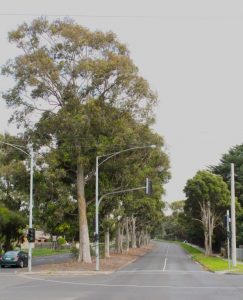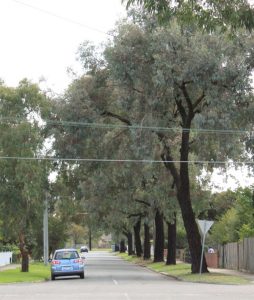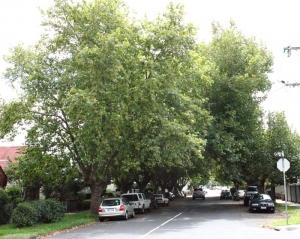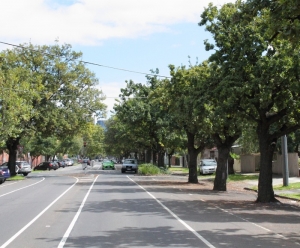There are many services that combine to make a liveable city. Effective sanitation, accessible public transport, well maintained public open spaces and recreational facilities are but a few such services. Large amounts of council revenue are spent every year on such services, maintaining them as assets to benefit all citizens’ mental and physical well-being.

Beautiful, dimpled bark of spotted gum, Corymbia maculata
While the built environment makes up the more noticeable public assets cities possess, the living environment is equally important. Parks, gardens and other public open spaces provide many widely acknowledged benefits to users, but there is one part of our urban environment that many people overlook. I am talking of course about the humble street tree. Those thousands of trees that line the city and suburban streets are sometimes maligned as much as they are marvelled at.
The consternation with which some people may regard their street’s trees is often misplaced or made out of a lack of foresight, because there is plenty to like about well selected and cared for street trees. Not only can they look beautiful but their benefits range from cooling urban environments right through to economic benefits, such as prolonging the longevity of footpaths and roads, saving rate payers untold thousands per year. Street trees are more of an asset than a liability, and here is a small showcase of some of Melbourne’s most beautiful, less well-known examples.
When thinking of street trees in Melbourne the classic examples first spring to mind. Elms adorn many a city street and have become as synonymous with Melbourne as the clocks in Flinders Street Station. As noteworthy as the elm population of Melbourne is, and as much as I adore them, there are many other tree species used in streetscapes around the city that deserve an equal mount of adoration. Plenty are natives – even indigenous – and others not, but ‘native’ is by no means the definitive criterion when it comes to great street trees. Reliable uniformity of trees is one of the most important considerations, as nothing looks more detracting than a street with unkempt trees, with the exception of a street completely denuded of them. Many gum trees are considered ill-fitting street trees owing to their often highly variable form within species, but two examples stand out around Melbourne as exceptions to this rule.

Avenue of majestic spotted gums in Melbourne
The Spotted Gum (Corymbia maculata) and Red Ironbark (Eucalyptus tricarpa) are two native trees that lend themselves to use as street trees. The latter is even indigenous to the Melbourne area. The spotted gum is a handsome tree that is named so owing to its beautifully spotted bark, making this species a real feature when planted en masse. Dark green foliage fills this tree’s canopy all year round and may reach a height of 20 metres or more.
Red ironbarkwill reach a similar height but its appearance is all together different. Where spotted gum’s bark is smooth and flaky, red ironbark is adorned with dark red-brown, highly fissured bark that really stands out. The leaves have a blue hue to them that contrasts beautifully with the bark.

Eucalyptus tricarpa has dark furrowed bark which contrasts with the soft blue-grey foliage
Unfortunately, red ironbark has developed a reputation for shedding limbs when stressed (a lot of gums do), which has resulted in them falling from favour with urban forest managers. While this reputation is probably deserved, and prudence says they should be avoided in streetscapes for that very reason, the only streets I know of in Melbourne that are planted with this species show no signs of stress. This is remarkable given that Melbourne has just emerged from over ten years of severe drought. Could red ironbark’s resilience in tougher times outweigh the fear of dropping limbs? I certainly think so, but convincing councils (and residents) is another matter entirely.

Spreading London planes, Platanus x acerifolia, give shade without footpath damage but with the downside of allergenic pollen
Limb shedding is one of the main reasons why gum trees are often avoided when it comes to selecting street trees. In a climate like Melbourne’s, it too makes a great deal of sense to consider deciduous trees that let winter’s sun flood in unimpeded. There are again many examples, one of the most successful as well as controversial are the plane trees (Platanus spp.). Plane trees tick all the boxes; they are fast growing, widely adaptable to many soils, have reliable form (especially pollarded around power lines) and are deciduous. The controversy surrounding their use in Melbourne is due mainly to their high allergen nature. Anyone who suffers from hay fever is advised to think twice about visit Melbourne in the early spring, when plane trees release pollen in vast amounts. Melbourne arborists consider the London plane tree (Platanus x acerifolia and cultivars) as over-planted around the city’s suburbs, and in many ways I agree with them. However, when it comes to trees that don’t rip up paving, as well as providing vast canopies of uninterrupted shade in the summer time, the London plane is arguably second to none. Love them or loath them, London plane trees have been a highly successful addition to Melbourne’s street tree taxa in recent decades.

English oak, Quercus robur, is being planted more widely for its deciduous, shade-giving canopy
A less controversial but equally successful street tree seen around Melbourne is the English oak (Quercus robur). This majestic species, as its name suggests, hails from the UK as well as most of Europe, and was widely planted around the city some eighty years ago. Many plantings are only now reaching maturity, with many more being planted recently in areas such as South Melbourne. The English oak has the enviable reputation for doing little damage to roads and footpaths through its root system, which is one of the reasons why it was planted widely in the past. It has a broad canopy and is a handsome tree that improves the look of any street it is found growing in.
Finally, the City of Melbourne has recently announced an urban forest policy, which aims to double the amount of tree canopy cover across the municipality. The policy aims higher than its concurrent replacement strategy, which sought to replace declining mature trees, particularly elms, in a bid to maintain Melbourne’s reputation as a leafy urban centre. Although the current residents of Melbourne will not see the fruition of this latest policy, those who will call Melbourne home in a century or more will have a lot to enjoy in the city’s collection of trees. Hopefully twice as much as us treeophiles do now.
Until next time, happy gardening.
